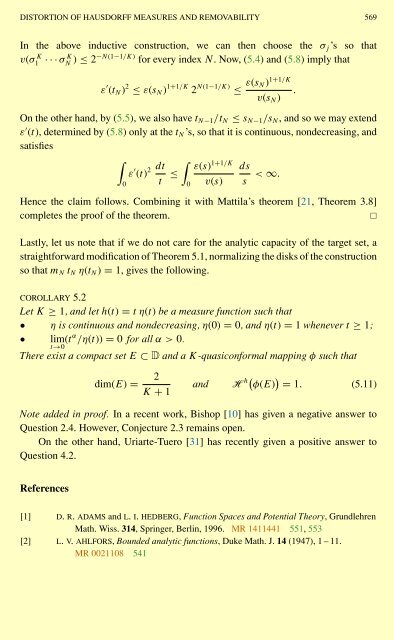A NULLSTELLENSATZ FOR AMOEBAS
A NULLSTELLENSATZ FOR AMOEBAS
A NULLSTELLENSATZ FOR AMOEBAS
You also want an ePaper? Increase the reach of your titles
YUMPU automatically turns print PDFs into web optimized ePapers that Google loves.
DISTORTION OF HAUSDORFF MEASURES AND REMOVABILITY 569<br />
In the above inductive construction, we can then choose the σ j ’s so that<br />
v(σ1<br />
K ···σ N K) ≤ 2−N(1−1/K) for every index N. Now,(5.4)and(5.8) imply that<br />
ε ′ (t N ) 2 ≤ ε(s N ) 1+1/K 2 N(1−1/K) ≤ ε(s N) 1+1/K<br />
.<br />
v(s N )<br />
On the other hand, by (5.5), we also have t N−1 /t N ≤ s N−1 /s N , and so we may extend<br />
ε ′ (t), determined by (5.8) only at the t N ’s, so that it is continuous, nondecreasing, and<br />
satisfies<br />
∫<br />
0<br />
ε ′ (t) 2 dt<br />
t<br />
∫<br />
≤<br />
0<br />
ε(s) 1+1/K<br />
v(s)<br />
ds<br />
s < ∞.<br />
Hence the claim follows. Combining it with Mattila’s theorem [21, Theorem 3.8]<br />
completes the proof of the theorem.<br />
<br />
Lastly, let us note that if we do not care for the analytic capacity of the target set, a<br />
straightforward modification of Theorem 5.1, normalizing the disks of the construction<br />
so that m N t N η(t N ) = 1, gives the following.<br />
COROLLARY 5.2<br />
Let K ≥ 1, and let h(t) = tη(t) be a measure function such that<br />
• η is continuous and nondecreasing, η(0) = 0, and η(t) = 1 whenever t ≥ 1;<br />
• lim<br />
t→0<br />
(t α /η(t)) = 0 for all α>0.<br />
There exist a compact set E ⊂ D and a K-quasiconformal mapping φ such that<br />
dim(E) = 2<br />
K + 1<br />
and H h( φ(E) ) = 1. (5.11)<br />
Note added in proof. In a recent work, Bishop [10] has given a negative answer to<br />
Question 2.4. However, Conjecture 2.3 remains open.<br />
On the other hand, Uriarte-Tuero [31] has recently given a positive answer to<br />
Question 4.2.<br />
References<br />
[1] D. R. ADAMS and L. I. HEDBERG, Function Spaces and Potential Theory, Grundlehren<br />
Math. Wiss. 314, Springer, Berlin, 1996. MR 1411441 551, 553<br />
[2] L. V. AHL<strong>FOR</strong>S, Bounded analytic functions, Duke Math. J. 14 (1947), 1 – 11.<br />
MR 0021108 541
















